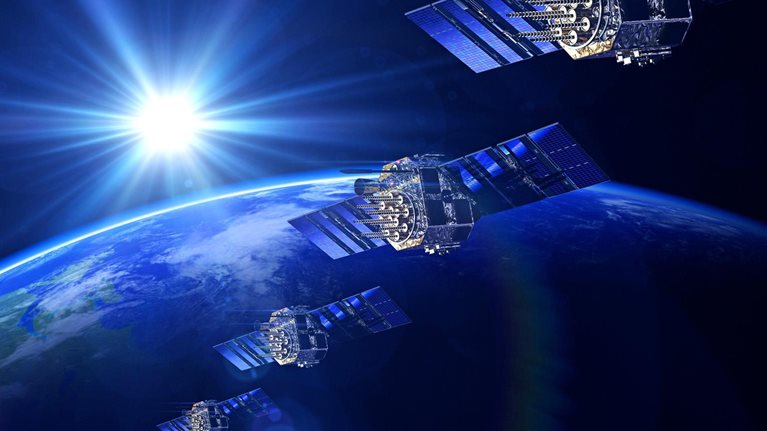One of the world’s largest constellations of satellites is operated not by a government but by a company that’s been around for only a decade. Spire Global, founded in 2012 by current CEO Peter Platzer and two colleagues, has more than 100 satellites orbiting just above Earth’s atmosphere. Platzer has been interested in space since his teenage years but took a circuitous route to the space industry: after spending a short time at the research organization CERN and at the Max Planck Institute, he worked as a consultant in Asia, attended business school, embarked on a Wall Street career, then went back to graduate school and interned at NASA. “The outcome of my graduate thesis was the starting point of Spire,” he says.
Today, Spire—which became a publicly traded company in August 2021—provides space-based data, analytics, and services to about 400 public- and private-sector entities. It has offices in Europe, North America, and Singapore and employs more than 350 people. McKinsey’s Jannick Thomsen recently interviewed Platzer about the future of Spire and of the space industry more broadly.
Spire’s role in space
Jannick Thomsen: There are a number of companies using satellites to observe Earth. What makes Spire different?
Peter Platzer: I sometimes wish we had different names for satellites. In transportation, everyone knows the difference between an aircraft, a ship, and a car. Even though they all have passengers, engines, and steering wheels, they are very different. The same holds true with satellites: there are what we call talking, looking, and listening satellites.
Talking satellites provide bandwidth and connectivity for telecommunications. Looking satellites, which are probably the most well known and largest part of Earth observation, rely on capturing reflections from the sun on the surface of the Earth. They provide a lot of visual information and great insights about land usage and river outflows, for example, but they only work during the day and when it’s not very cloudy.
Spire focuses on listening satellites, which use a broad spectrum of radio frequencies to observe what is happening on Earth. The advantage is that you can use these satellites day and night, 24/7, in any weather conditions, across the entire planet.
Jannick Thomsen: How do the data from Spire’s satellites help improve life on Earth?
Peter Platzer: Here’s an example. One of the data types that Spire collects is information on weather: temperature, pressure, moisture of the atmosphere, and so on. Weather information is crucial; it affects at least a third of the global economy and 100 percent of the world population. That data is fed into governments’ weather prediction models, including those of the European Union and the United States, and the outputs are freely available. You can use this information to see if you need to carry an umbrella or to check driving conditions on the roads. Farmers use it to determine when they should harvest or water crops. In construction, workers could use the data to see if it will be too windy to operate a crane. In rough numbers, I’d say we’re improving weather prediction accuracy for a billion people and for countries that contribute about 50 percent of global GDP.
Jannick Thomsen: What are some surprising ways that customers have used Spire’s data?
Peter Platzer: A couple of years ago, a huge locust swarm was destroying crops in Africa. By combining our data with other information, such as rainfall levels, we could not just track but predict where the swarm would go. That was an unusual and unexpected use of space-based assets to make a real difference to people on Earth. We replicated this approach a few months later when cicadas were coming out in the United States.

The future of space: It’s getting crowded out there
Capturing a niche in the crowded space ecosystem
Jannick Thomsen: Space-based applications were once developed exclusively by governments, but commercial companies are now leading the way. What’s behind this change?
Peter Platzer: The capability per kilogram of a satellite has been increasing about tenfold every five years for over two decades. The miniaturization of sensors—along with increases in accuracy, power efficiencies, and processing capabilities—all drive that improvement curve and result in the explosion of use cases for space to solve problems on Earth. It’s similar to how Moore’s Law helped move computer use and deployment from only governments to the commercial sector.
A secondary reason for commercial growth relates to the availability of launch. Many people are not aware that a rocket goes up somewhere on this planet about every three days. Historically, commercial entities couldn’t use rockets to deploy satellite constellations, but that changed in the late 1990s, when technology pioneers replaced sand and water—which was used for ballast on rockets—with secondary payloads. Spire has conducted more than 30 launch campaigns, launching over 150 satellites over the past few years.
Finally, lower launch costs are a factor. Launch costs for large structures have fallen to about half of what they were. That has helped make large-scale structures in space—like mega-constellations, private space stations, and moon outposts—a possibility.
Jannick Thomsen: Indeed, in the past five to ten years, many start-ups have entered the space market. How do you think the space ecosystem will evolve?
Peter Platzer: We can look to the computer industry for some answers, since it is very similar to the space industry. The disruption from mainframe computers to personal computers and, eventually, to the internet is an almost perfect analog to what is happening in the space industry.
We have a few dominant internet players today, but there are almost no companies that don’t use the internet and computers. I think that is where the space industry is headed: there will be some large players, but the use of space will be widely distributed because access to it is becoming more regular.
In the 1980s and 1990s, the concept that even a large company would have its own supercomputer was absurd—and now every start-up has a supercomputer. Today, the concept that even large companies would have a private satellite constellation for their own needs is pretty absurd. I think in 15 years it will be commonplace.
Jannick Thomsen: Spire has been successful over the past decade. What advice would you give to another space start-up?
Peter Platzer: If you solve customers’ pain points, they’re going to be willing to pay for your services. In that respect, I don’t think a space business is different from any other business. Don’t get excited about a new technology; instead, get excited if your particular technology addresses customer problems better than any other solution.
At Spire, the problems we are solving for customers can only be solved from space. I think that’s how space companies can be most successful: focus on problems that can exclusively be solved from space. If they can be solved a different way, don’t use space.
What the future holds
Jannick Thomsen: What’s an example of something that Spire will be able to do, in ten or 15 years, that it cannot do now?
Peter Platzer: Some estimates suggest that the cost of inaccurate weather predictions is in the $2 trillion to $4 trillion range. That number will increase because of climate change. So, a big part of our mission is to make weather prediction as accurate as Swiss train schedules.
If Spire can be part of giving that capability to humanity—the capability of planning ahead for wildfires, hurricanes, floods—through our data and analytics, we would have a massive impact. We could help humanity adapt to climate change. Many experts believe that space, especially Earth observation, is inexorably connected to humanity’s struggle with climate change. I think that’s true, since it’s only from space that we can monitor the entire Earth 24/7.
Jannick Thomsen: More broadly, what do you think space will be like in 2030? What will people and companies be able to do in space?
Peter Platzer: Let's talk about 2035 instead, since I have a slightly better grasp of what things might be like by then. I think that by then, space will be ubiquitously used to understand, steer, and improve life on Earth, in the same way that the internet is now used for these purposes.
As I said, there’s been a tenfold increase in capability per kilogram every five years. If we look ahead 15 years, that’s a 1,000-fold increase in capability per kilogram. We’ll be able to launch larger and larger structures. As space exploration increases, we will want to build more structures in space and on the moon. In-orbit manufacturing—the ability to build structures in space, perhaps using autonomous robots—is going to be important, and I think we’ll start seeing some of that in 15 years.
I believe we will have structures in space that are commercially owned and operated. Some will be for research. Others will be for tourism—maybe a space station, but it won’t be as comfortable as a hotel. And we will have some kind of presence on the moon; people might be able to plan weeklong trips to the moon.
By 2035, I believe we will have found life in our solar system. There are a number of very promising locations, and we are at a point where commercial operators can launch a life-seeking mission to Mars or to Venus at a much lower cost than in the past. That changes the game; I believe it will generate more interest. The increase in accessibility makes me hopeful that 15 years from now, we’ll all see a short video clip that shows life on another planet.



